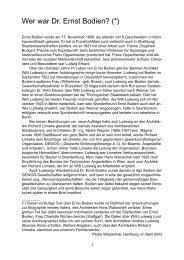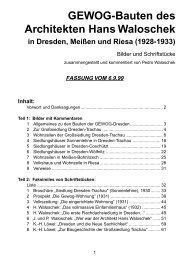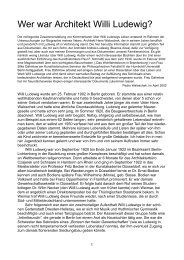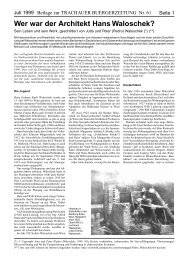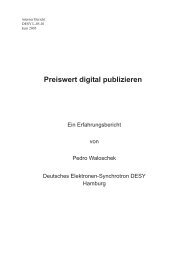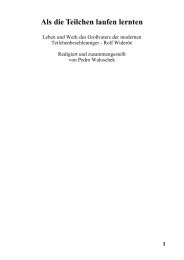Death-Rays as Life-Savers in the Third Reich - Pedro Waloschek ...
Death-Rays as Life-Savers in the Third Reich - Pedro Waloschek ...
Death-Rays as Life-Savers in the Third Reich - Pedro Waloschek ...
Create successful ePaper yourself
Turn your PDF publications into a flip-book with our unique Google optimized e-Paper software.
how closely Gans and Gerlach were befriended and how frequently<br />
<strong>the</strong>y used to meet or speak on <strong>the</strong> telephone dur<strong>in</strong>g that period. Gans’<br />
home <strong>in</strong> Berl<strong>in</strong> w<strong>as</strong> never without a telephone connection dur<strong>in</strong>g <strong>the</strong><br />
war, even when he had to move after his build<strong>in</strong>g w<strong>as</strong> destroyed <strong>in</strong> a<br />
bomb<strong>in</strong>g raid.<br />
At any rate, many highly regarded scientists expressed positive<br />
op<strong>in</strong>ions about <strong>the</strong> Rheotron plan, and f<strong>in</strong>ally Schmellenmeier first took<br />
on <strong>the</strong> t<strong>as</strong>k of draft<strong>in</strong>g a proposal and <strong>the</strong>n agreed to work on its<br />
realisation <strong>in</strong> his laboratory, should a contract be forthcom<strong>in</strong>g.<br />
Rheotrons were not unknown <strong>in</strong> Germany at <strong>the</strong> time. They were<br />
even thought of <strong>as</strong> a German <strong>in</strong>vention, and had been patented under<br />
<strong>the</strong> name ‘Elektronenschleuder’ (‘electron catapults’) <strong>in</strong> 1933 and<br />
1935 by <strong>the</strong> physicist Max Steenbeck (1904-1981), who w<strong>as</strong><br />
employed by Siemens-Schuckert <strong>in</strong> Berl<strong>in</strong>-Siemensstadt [Ru33]<br />
[St35]. However, <strong>the</strong> electron beam produced by <strong>the</strong> experimental<br />
apparatus that Steenbeck developed <strong>in</strong> strict secrecy w<strong>as</strong> so weak<br />
that Siemens decided to stop <strong>the</strong> project.<br />
The crucial factor that w<strong>as</strong> to arose such a high degree of <strong>in</strong>terest <strong>in</strong><br />
<strong>the</strong> Rheotron and <strong>the</strong> ‘electron catapult’ w<strong>as</strong> an article written <strong>in</strong> 1941<br />
and published <strong>in</strong> <strong>the</strong> l<strong>as</strong>t issue of ‘Physical Review’ to be distributed <strong>in</strong><br />
Germany dur<strong>in</strong>g <strong>the</strong> <strong>Third</strong> <strong>Reich</strong>. In this article <strong>the</strong> American physicist<br />
Donald William Kerst (1911-1993) [Ke41b] described a relatively<br />
small piece of apparatus <strong>in</strong> which electrons coursed around a circle<br />
with a diameter of only 15 centimetres. The energy achieved by <strong>the</strong><br />
electrons w<strong>as</strong> <strong>the</strong> same <strong>as</strong> that, which would result from accelerat<strong>in</strong>g<br />
<strong>the</strong>m with an electric potential of 2.3 million Volts. The equipment,<br />
<strong>in</strong>clud<strong>in</strong>g <strong>the</strong> required magnet, me<strong>as</strong>ured less than 50 centimetres <strong>in</strong><br />
width and could e<strong>as</strong>ily be placed on a laboratory table. The<br />
<strong>as</strong>tonish<strong>in</strong>g th<strong>in</strong>g w<strong>as</strong> <strong>the</strong> <strong>in</strong>tensity of <strong>the</strong> X-rays which resulted from<br />
<strong>the</strong> electron beams hitt<strong>in</strong>g a suitable material, and which Donald Kerst<br />
w<strong>as</strong> able to me<strong>as</strong>ure. In <strong>the</strong> first apparatus this w<strong>as</strong> more or less<br />
equivalent to <strong>the</strong> radiation produced by a tenth of a gram of radium,<br />
and <strong>in</strong> a second device this rose to <strong>the</strong> radiation produced by an entire<br />
42



